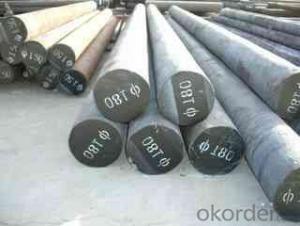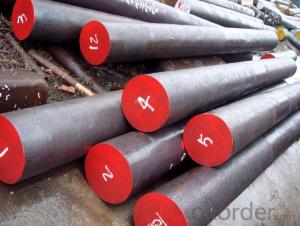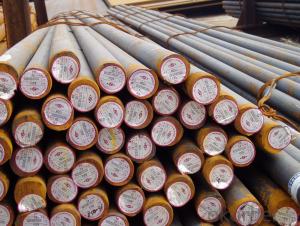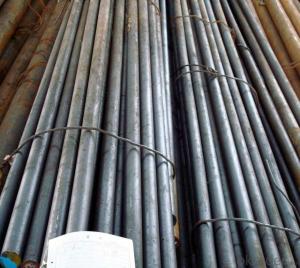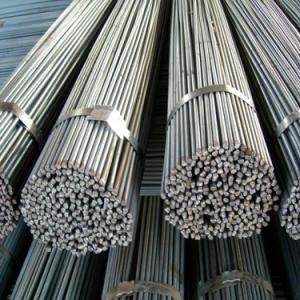JIS /GB/DIN alloy round steel bar 100*100
- Loading Port:
- Tianjin
- Payment Terms:
- TT OR LC
- Min Order Qty:
- 200 m.t.
- Supply Capability:
- 10000 m.t./month
OKorder Service Pledge
OKorder Financial Service
You Might Also Like
Product Description:
Specifications of American Standard Round Bar
1. Grade: ASTM A36; AISI 1006-1025
2. Sizes: Diameter: 6mm-150mm; Length: 6m, 9m, 12m or as customer’s request
3. Tolerance: Within ±5% for weight; ±2mm for diameter
4. Type: Mild steel; Low carbon steel
5. Shape: Round bar, solid bar of steel with circular section
6. Technique: Hot rolled or cold drawn
7. Mass: Mass (kg/m) = Diameter (mm) × Diameter (mm) × 0.00617
Usage and Applications of American Standard Round Bar
1. American standard is the most common form of steel as its price is relatively low while it provides material properties that are acceptable for many applications. American standard round bar is often used where large amounts of steel need to be formed, for example as structural steel.
2. And we can use this kind of product on the performance of the mechanical parts if the demand is not very high.
3. Steel round bar is used in construction and a large number of architectural and engineering structures.
4. Some special round bar can be used for automotive engine and transmission components, bearing, rails machine tools and wire rope.
Packaging & Delivery of American Standard Round Bar
Packaging Detail: All goods are packed in bundle with steel strips and shipped by break bulk vessel or container (depend on target market and different ports)
Delivery Detail: 45 days
Trade terms: FOB, CFR, CIF
MOQ: 25 tons per specification; we can negotiate the quantity if the specification is normal or we have stock of one specification.
Weight: The price invoicing on theoretical weight basis or actual weight basis depends on customer’s request.
Shipment: The shipment of bulk break or container is depends on customer’s request and the situation of the port of destination.
Documents given: Full set of original clean on board bill of lading; Original signed commercial invoice; Original packing list; Policy of insurance; Certificate of origin and what the target market needs.
Production Flow of American Standard Round Bar
The common processes are preheated forging quenching, dual refinement solution process, cooling quenching and isothermal quenching. We use heat treatment for dual refinement solution process.
Quality Assurance of American Standard Round Bar
1. We will strictly inspect our production that we sold according to the customer’s request.
2. Quality should be in conformity with the specification of the manufacturer. Quantity and packing conditions should be in conformity with the term in the contract.
3. Should the packing found damaged, the buyer has the right to claim to the seller.
- Q:What is the tolerance for diameter in steel round bars?
- The tolerance for diameter in steel round bars can vary depending on the specific standards and requirements set by the manufacturer or industry. Generally, the tolerance for diameter in steel round bars is specified within a certain range to ensure the desired level of precision and consistency in the dimensions of the bars. This tolerance is usually expressed as a plus or minus value, indicating the acceptable deviation from the specified diameter. It is important to check the relevant industry standards or consult with the manufacturer to determine the specific tolerance for diameter in steel round bars, as it can differ based on the intended application and the manufacturing process used.
- Q:What are the different grades of stainless steel round bars?
- There are several grades of stainless steel round bars, with the most common ones being 304, 316, and 410. These grades differ in their chemical composition, strength, and corrosion resistance properties, making them suitable for various applications in different industries.
- Q:What are the different bending methods for steel round bars?
- Different bending methods can be used for steel round bars, depending on the desired outcome and specific application. Some of the commonly employed methods for bending steel round bars include: 1. Cold Bending: Steel round bars are bent at room temperature without the application of heat. Specialized bending machines or tools are used to exert force on the bar and achieve the desired shape. 2. Heat Bending: The steel round bar is heated to a specific temperature to increase its malleability, making it easier to bend. Specialized tools or fixtures are then used to bend the heated bar. Heat bending is ideal for intricate or precise bends that cannot be achieved through cold bending alone. 3. Induction Bending: This process involves using an induction coil to locally heat the steel round bar, enabling gradual and smooth bending. Induction bending is commonly used for large diameter or thick-walled round bars, providing better control over the bending process and minimizing distortion or damage to the material. 4. Roll Bending: Steel round bars are passed between a set of rollers that gradually bend them into the desired shape. Roll bending is often employed for larger diameter or longer round bars, as the continuous support from the rollers ensures consistent bending along the entire length of the bar. 5. Mandrel Bending: Mandrel bending involves inserting a rod, known as a mandrel, inside the steel round bar to support the inner walls during the bending process. This technique helps the bar maintain its shape and prevents the formation of wrinkles or deformations on the inside of the bend. Each bending method has its own advantages and limitations. The choice of method depends on factors such as the size and thickness of the round bar, the required bend radius, and the desired quality of the final product. Consulting with experts or professionals in the field is crucial to determine the most suitable bending method for a specific steel round bar application.
- Q:Can steel round bars be used in the manufacturing of agricultural equipment?
- Yes, steel round bars can be used in the manufacturing of agricultural equipment. Steel is a strong and durable material that provides the necessary strength and structural integrity required for agricultural machinery. It is commonly used in the production of components such as axles, shafts, and supports, making it suitable for various types of farming equipment.
- Q:What is a steel round bar?
- A steel round bar is a long, cylindrical metal rod with a circular cross-section. It is typically made from steel, which is a strong and durable alloy composed primarily of iron and carbon. The round bar is commonly used in various industries such as construction, manufacturing, and engineering due to its versatility and reliability. It is often used as a structural component in buildings, as support or reinforcement in concrete structures, or as a component in machinery and equipment. The round shape allows for easy handling, machining, and welding processes. Steel round bars come in various diameters and lengths, and they can be further customized or fabricated to meet specific project requirements.
- Q:Can steel round bars be used in the hospitality industry?
- Yes, steel round bars can be used in the hospitality industry. They can be utilized for various applications such as constructing furniture, fixtures, and equipment, as well as for structural purposes in buildings and facilities. Steel round bars offer durability, strength, and versatility, making them suitable for use in various hospitality settings such as hotels, restaurants, and entertainment venues.
- Q:What is the difference between a centerless ground and a polished steel round bar?
- A centerless ground steel round bar and a polished steel round bar are both types of steel bars that have undergone different finishing processes, resulting in distinct qualities and characteristics. A centerless ground steel round bar is produced by grinding the surface of the steel bar using a specialized machine called a centerless grinder. This process removes any imperfections or irregularities on the surface, resulting in a smooth and uniform finish. The centerless grinding process also ensures that the diameter of the bar remains consistent throughout its length. This makes centerless ground steel round bars ideal for applications that require precise dimensions and a smooth surface, such as in machining operations or as a base material for further processing. On the other hand, a polished steel round bar is achieved through a polishing process, where the surface of the steel bar is buffed and polished using abrasive materials. This process helps to enhance the aesthetic appearance of the steel bar, giving it a shiny and reflective surface. Unlike centerless grinding, polishing does not involve removing material from the surface but rather smoothing and refining it. Polished steel round bars are often used in decorative applications, such as in architecture, interior design, or as components in high-end furniture. In summary, the main difference between a centerless ground steel round bar and a polished steel round bar lies in the finishing process. Centerless grinding focuses on achieving precise dimensions and a smooth surface, making it suitable for functional applications. On the other hand, polishing aims to enhance the visual appeal of the steel bar, making it more suitable for decorative purposes.
- Q:Can steel round bars be used for gear applications?
- Yes, steel round bars can be used for gear applications. Steel round bars are often used for manufacturing gears due to their high strength, durability, and ability to withstand heavy loads and wear. They can be machined and heat-treated to meet specific gear requirements, making them a suitable choice for various gear applications in industries such as automotive, machinery, and manufacturing.
- Q:How do you calculate the cross-sectional area of a steel round bar?
- To calculate the cross-sectional area of a steel round bar, you need to know its diameter or radius. The formula for calculating the cross-sectional area of a circle is A = πr^2, where A is the area and r is the radius of the circle. If you have the diameter of the round bar, you can divide it by 2 to get the radius. Once you have the radius, you can substitute it into the formula to calculate the cross-sectional area. Keep in mind that the value of π is approximately 3.14159.
- Q:Are steel round bars magnetic?
- Yes, steel round bars are generally magnetic due to their high iron content.
1. Manufacturer Overview |
|
|---|---|
| Location | |
| Year Established | |
| Annual Output Value | |
| Main Markets | |
| Company Certifications | |
2. Manufacturer Certificates |
|
|---|---|
| a) Certification Name | |
| Range | |
| Reference | |
| Validity Period | |
3. Manufacturer Capability |
|
|---|---|
| a)Trade Capacity | |
| Nearest Port | |
| Export Percentage | |
| No.of Employees in Trade Department | |
| Language Spoken: | |
| b)Factory Information | |
| Factory Size: | |
| No. of Production Lines | |
| Contract Manufacturing | |
| Product Price Range | |
Send your message to us
JIS /GB/DIN alloy round steel bar 100*100
- Loading Port:
- Tianjin
- Payment Terms:
- TT OR LC
- Min Order Qty:
- 200 m.t.
- Supply Capability:
- 10000 m.t./month
OKorder Service Pledge
OKorder Financial Service
Similar products
New products
Hot products
Related keywords
